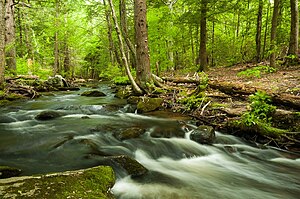Mad River (Connecticut)
| Mad River | |
|
Mad River courses through woodlands in Wolcott during late May.
|
|
| Country | United States |
|---|---|
| State | Connecticut |
| Counties | New Haven County |
| Municipalities | Wolcott, Waterbury |
| Tributaries | |
| - left | Lindsley Brook, Finch Brook |
| - right | Break Hill Brook, Old Tannery Brook |
| Source | Outlet of Cedar Lake |
| - location | Wolcott (though Cedar Lake extends north into Bristol) |
| - coordinates | 41°38′10″N 72°58′13″W / 41.63611°N 72.97028°W |
| Mouth | Naugatuck River |
| - location | Waterbury |
| - coordinates | 41°32′30″N 73°02′22″W / 41.54167°N 73.03944°WCoordinates: 41°32′30″N 73°02′22″W / 41.54167°N 73.03944°W |
| Length | 11 mi (18 km) |
| Basin | 20.35 sq mi (53 km2) |
The Mad River is a river that flows through northern New Haven County, Connecticut in the United States. Rising at the outlet of Cedar Lake just south of Bristol, it courses roughly 11 miles through Wolcott and Waterbury before emptying into the Naugatuck River.
Prior to settlement by the Connecticut Colony, the broad region encompassing the Mad River was a hunting ground frequented by native Algonquian people of the Mattabesec and Tunxis tribes. The territory was known to these inhabitants as "Mattatuckoke", believed to translate to "place without trees", and it correlated roughly to what is today referred to as the Central Naugatuck Valley. These lands were purchased and settled by individuals from the Connecticut Colony during the 1670s and 1680s.
Prior to the industrialization of the Naugatuck Valley, local mills harnessed the waters of the Mad River to produce goods such as flour, cider and saw timber. The river's economic importance grew enormously as brass manufacturing rose to prominence in the region in the mid-1800s. Several large factories in Waterbury relied upon the Mad River to animate heavy machinery, even though the river's modest watershed was prone to yield insufficient waterflow during dry spells. Consequently, the Mad River and a few of its tributaries were impounded upstream in rural Wolcott, creating a system of reservoirs which could be used to supplement reduced waterflow during seasonal droughts.
By the late 19th-century, the lower stretches of the Mad River were known to be tremendously polluted by industrial operations. Factory waste, as well as sewage produced by throngs of factory workers, was discharged directly into the river. One observer of the Mad River in 1887 noted that water downstream of Scovill Manufacturing Company, one of the foremost brass producers in Waterbury, "showed extreme contamination; it was of a dark turbid color, with a strong odor and was covered with iridescent films of oily and greasy matters".
Strengthened environmental regulations in the 1970s forbade the release of toxic chemicals into both Mad River and the nearby Naugatuck River and tightened restrictions on the pollutants billowing from the factory smokestacks. Significant industrial pressure on the Mad River ceased by the 1980s when the brass and copper companies in Waterbury, which had been in decline since World War II, shuttered the last of their major factories.
...
Wikipedia

